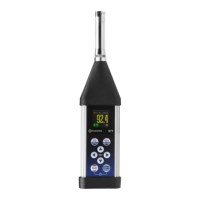12 REVERBERATION TIME MEASUREMENTS – RT60
The RT60 analysis is an optional function of SV 971A, which provides reverberation time calculation for
1/1-octave bands (from 63 Hz to 8 kHz) or 1/3-octave bands (from 50 Hz to 10 kHz) and three total RMS
levels (A, C and Z weighted). Whole measurement process and calculations implemented in SV 971A
fulfil the ISO 3382 standard.
The reverberation time of the room can be obtained with the use of SV 971A by two measurement
methods: Impulse Response Method (Impulse) and Interrupted Noise Method (Decay). The selection of
the method depends on the type of the used sound source. The Impulse method is designed for
measurements using the impulse sound source (like pistol shot, petard explosion), whereas the Decay
method is intended for measurements when room is excited by broad or narrow band sound noise source
(usually pink noise). For more details about the measurement and calculation process see Appendix E.
The reverberation time analysis applied in the instrument consists of two parts:
1. The measurement part during which the acoustic response of the room is registered.
2. The calculation part during which the reverberation time (EDT, RT20 and RT30) is calculated
for the measured room response.
Note: It is recommended to familiarize with Appendix E before proceeding. This chapter
describes only the navigation of the instruments, whereas Appendix E depicts the definitions
and describes reverberation time measurements.
12.1 SELECTING RT60 FUNCTION
To activate the RT60 function, enter the Function
section, select the Meas. Funct position and press the
<Enter> key. In the Meas. Funct screen, select the
RT60 function and press the <Enter> key.
Note: The RT60 function is optional and should be unlocked by entering the activation code
in the text editor screen, which is opened after first attempt to select this function. Once
unlocked this option will be available permanently.
12.2 SETTING RT60 PARAMETERS – RT60 SETTINGS
Execution of the RT60 analysis depends on a certain number of the parameters,
which can be set in the different screens of the Measurement section:
RT60 Settings, Compensation Filter and Range.
Positions Range and Compensation Filter are the same as for the SLM
functions (see Chapters 4.6 and 4.7).
The RT60 Settings list allows to select the method for
RT60 calculations, define the name of the file, where the
registered data will be collected, and other parameters
for RT60 calculations.
The Start Delay parameter defines the delay period
from the moment the <Start> keystroke to the start of the
actual measurement.

